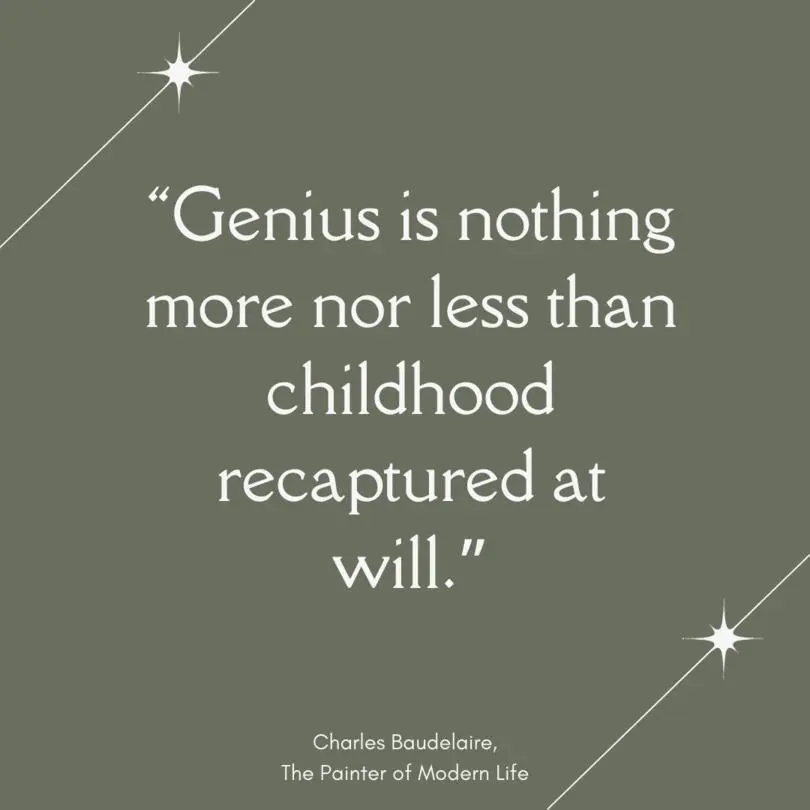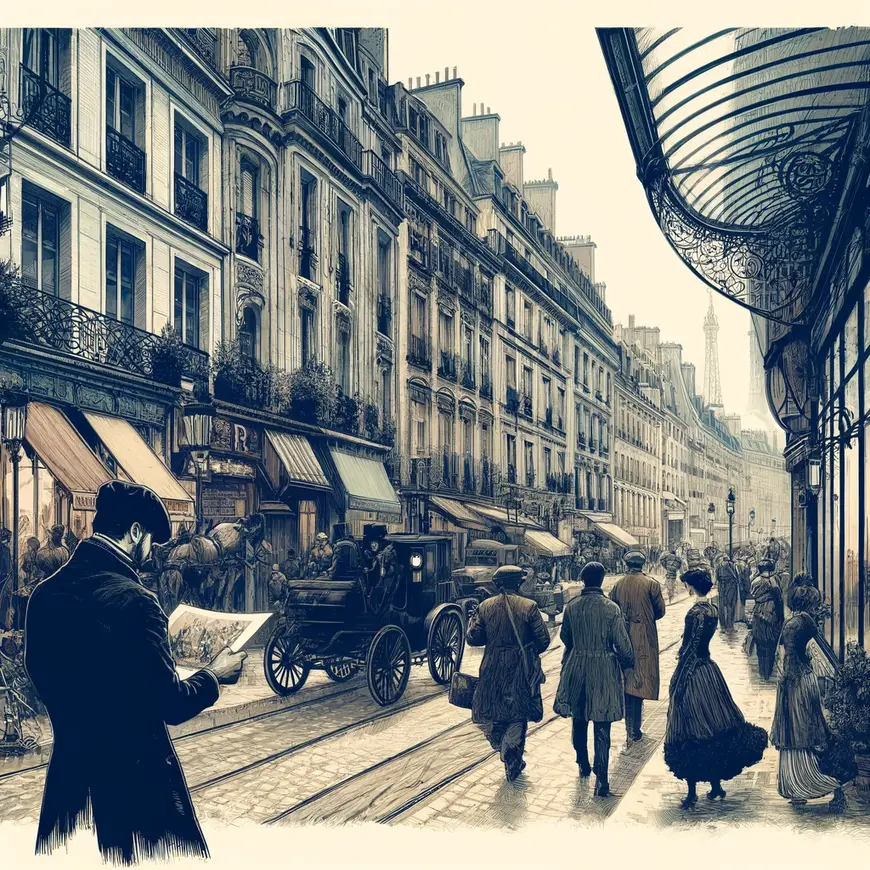the Canvas of Urban Existence: “The Painter of Modern Life” by Charles Baudelaire
Charles Baudelaire, a poetic luminary of the 19th century, invites readers into the vibrant tapestry of modernity through his seminal work, “The Painter of Modern Life.” This collection of essays serves as a philosophical exploration of the evolving urban landscape, where Baudelaire dissects the complexities of contemporary existence, art, and the indomitable spirit of the flâneur. In this captivating journey through the streets of Paris and the recesses of the human soul, Baudelaire emerges as both an astute observer and a poetic visionary, challenging readers to see the world anew.
The Flâneur: A Stroll Through the Streets of Modernity
At the heart of Baudelaire’s exploration is the figure of the flâneur, a detached yet engaged spectator of the bustling city life. In a society rapidly transformed by industrialization and urbanization, the flâneur emerges as a poetic archetype—an individual who navigates the streets with a keen eye for detail and an insatiable curiosity about the world.
Baudelaire, in his characteristically eloquent prose, extols the virtues of the flâneur as a modern-day hero, equipped with a unique ability to find beauty in the mundane. The act of strolling through the city streets becomes a deliberate and artistic endeavor for the flâneur, transforming the everyday into the extraordinary.

The Modern Artist: A Mirror Reflecting Society
Baudelaire’s essays delve into the essence of modernity, dissecting the role of the artist in capturing the spirit of the times. The painter of modern life, as envisioned by Baudelaire, is an artist attuned to the pulsating rhythms of contemporary existence—a visionary capable of distilling the essence of the age onto canvas.
The modern artist, according to Baudelaire, is not confined to the studios but is an active participant in the throbbing vitality of the city. The streets, cafes, and marketplaces become the artist’s palette, and the human experience, with all its contradictions and complexities, serves as the subject matter.
The Aestheticization of Everyday Life: Finding Beauty in the Commonplace
One of the central tenets of Baudelaire’s philosophy is the notion of elevating the ordinary to the realm of art. In the midst of the burgeoning urban landscape, with its crowded streets and teeming masses, Baudelaire discerns the potential for beauty. He challenges the prevailing aesthetic norms, advocating for an appreciation of the commonplace—a celebration of the fleeting moments that define modern life.
Baudelaire’s vision is revolutionary, urging readers to cast away preconceived notions of beauty and embrace the transient, the ephemeral. The city itself becomes a grand spectacle, and the artist’s task is to discern the poetry woven into the fabric of everyday existence.
Fashion and Modernity: The Ever-Changing Canvas
In “The Painter of Modern Life,” Baudelaire pays particular attention to the realm of fashion—a dynamic and ever-changing aspect of modern existence. Fashion, according to Baudelaire, is not merely about clothing; it is a reflection of the zeitgeist, a language that speaks to the evolving tastes and sensibilities of society.
The dandy, a figure of elegance and style, becomes emblematic of Baudelaire’s celebration of fashion. The dandy is not merely concerned with clothing but embodies an attitude—an intentional cultivation of one’s persona as a work of art. Baudelaire’s exploration of fashion transcends the superficial, delving into the profound connection between personal expression and the spirit of the age.
The Poet as Visionary: Baudelaire’s Lyrical Reflections
As a poet, Baudelaire infuses “The Painter of Modern Life” with lyrical reflections that resonate with an enduring poetic sensibility. His prose is imbued with a richness of language that elevates the philosophical discourse into a work of art in itself. Baudelaire’s ability to articulate complex ideas with a poetic flourish invites readers into a realm where philosophy and art converge seamlessly.
The poet’s gaze, keen and perceptive, captures the nuances of the urban panorama. Baudelaire’s writing transcends mere observation; it becomes a form of communion with the soul of the city. Each essay is a brushstroke on the canvas of modern life, creating a portrait that is both intimate and expansive.
The Dark Side of Modernity: Aestheticizing Decay and Baudelairean Melancholy
The juxtaposition of beauty and decay, vitality and melancholy, creates a chiaroscuro effect in Baudelaire’s vision. The artist, in Baudelaire’s view, must confront the shadows as much as the light, navigating the complex interplay between creation and destruction.
While Baudelaire celebrates the vibrancy of modern life, he is not blind to its darker aspects. The underbelly of the city—the poverty, decay, and the disquieting pace of change—finds a place in Baudelaire’s reflections. Yet, far from dismissing these elements, Baudelaire aestheticizes the melancholy inherent in the modern condition.

Famous Quotes from “The Painter of Modern Life” by Charles Baudelaire
- “Modernity is the transient, the fleeting, the contingent; it is one half of art, the other being the eternal and the immutable.” Explanation: Baudelaire defines modernity as something that is constantly changing and ephemeral, contrasting it with the timeless and unchanging aspects of art. He suggests that true art captures both the transient nature of contemporary life and the eternal human experience.
- “Genius is nothing more nor less than childhood recovered at will.” Explanation: Baudelaire believes that the essence of genius lies in the ability to see the world with the freshness and wonder of a child, suggesting that creativity stems from maintaining a sense of curiosity and openness.
- “The pleasure we derive from the representation of the present is due not only to the beauty it can be clothed in, but also to its essential quality of being present.” Explanation: This quote emphasizes the unique joy found in experiencing and representing the present moment. Baudelaire argues that part of the beauty of modern art comes from its immediacy and relevance to contemporary life.
- “By ‘modernity’ I mean the ephemeral, the fugitive, the contingent, the half of art whose other half is the eternal and the immutable.” Explanation: Similar to the first quote, this statement reiterates Baudelaire’s idea of modernity, highlighting the importance of capturing the fleeting moments of life while also acknowledging the enduring aspects of human experience.
- “The lover of life makes the whole world his family.” Explanation: Baudelaire suggests that someone who loves life embraces all its diversity and finds a sense of connection with everything and everyone. This reflects the modern artist’s role in observing and engaging with the world around them.
- “He is looking for that indefinable something we may be allowed to call modernity, for want of a better term, that something he pinpoints, that one quality which is always associated with beauty, that aspect of beauty which we must call ‘present-day.'” Explanation: Baudelaire describes the modern artist’s quest to capture the essence of contemporary beauty, something that is inherently tied to the present moment and reflects the spirit of the times.
Trivia Facts about “The Painter of Modern Life”
- Published in 1863: “The Painter of Modern Life” was first published in the Paris newspaper Le Figaro in 1863, during the height of the Second Empire in France.
- Inspired by Constantin Guys: Baudelaire wrote this essay based on the work of Constantin Guys, a journalist and illustrator who captured scenes of contemporary Parisian life. Baudelaire admired Guys’ ability to depict modernity and considered him the quintessential “painter of modern life.”
- Concept of Modernity: The essay is famous for introducing the concept of “modernity” (modernité) as an artistic and cultural principle. Baudelaire defined modernity as the fleeting, ephemeral experience of life in an urban metropolis, juxtaposed with the eternal and immutable aspects of beauty.
- Influence on Impressionism: Baudelaire’s ideas in this essay influenced the Impressionist movement. Artists like Édouard Manet, Claude Monet, and others were inspired by Baudelaire’s call to capture modern life and its transient beauty.
- Flâneur: Baudelaire popularized the idea of the flâneur in this essay—a detached observer of urban life who strolls through the city, experiencing and recording its moments. The flâneur became a key figure in the understanding of modernity and urban experiences.
- Critical Reception: At the time of its publication, Baudelaire’s essay was both praised and criticized. Some appreciated his insights into modern life and art, while others found his views controversial or overly subjective.
- Impact on Future Art Criticism: “The Painter of Modern Life” has had a lasting impact on art criticism and theory. It continues to be studied for its innovative ideas about the role of the artist and the nature of modern life.
- Baudelaire’s Personal Struggles: Baudelaire wrote this essay during a period of personal and financial difficulties. Despite his struggles, he produced some of his most influential work during this time.
- Exploration of Beauty: The essay delves deeply into the nature of beauty, arguing that true beauty lies in the combination of the eternal and the ephemeral. Baudelaire believed that artists should capture the essence of their contemporary moment while also touching on timeless themes.
Legacy and Influence: Baudelaire’s Lasting Impact on Modern Thought
“The Painter of Modern Life” has left an indelible mark on the trajectory of modern thought. Baudelaire’s insights into the relationship between art and society, the celebration of the ordinary, and the role of the artist as a cultural seer continue to reverberate in contemporary discussions.
His elevation of the flâneur as a symbol of modern consciousness has influenced thinkers and artists across disciplines. The concept of finding beauty in the commonplace, a central theme in Baudelaire’s work, resonates with movements such as surrealism and pop art, where artists seek to unearth the extraordinary in the everyday.
Baudelaire’s legacy extends beyond the realm of literature into the domains of philosophy, art criticism, and cultural theory. His keen observations on the transformative nature of modernity remain relevant, providing a lens through which we can examine our own rapidly evolving world.
Conclusion: A Stroll Through the Galleries of Modernity
In “The Painter of Modern Life,” Charles Baudelaire invites readers on a captivating stroll through the galleries of modernity—a journey that transcends the confines of time and space. His essays, a harmonious blend of philosophy and poetry, challenge us to reconsider our perceptions of beauty, art, and the ever-changing landscapes of contemporary existence.
As we traverse the bustling streets of Baudelaire’s Paris, we encounter the flâneur, the dandy, and the poetic visionaries who navigate the complexities of modern life. Baudelaire’s legacy endures as a testament to the enduring power of art to illuminate the intricacies of the human experience.
“The Painter of Modern Life” remains a timeless exploration of the symbiotic relationship between the artist and the world, a testament to the idea that the act of creation is not confined to the studio but is a dynamic engagement with the pulse of life itself. Baudelaire’s work beckons us to become flâneurs of our own existence, to stroll through the galleries of modernity with open eyes and receptive hearts, ready to embrace the beauty woven into the fabric of the everyday.
More Reviews of Works by Baudelaire
Le Spleen de Paris (by Baudelaire)
A Deep Dive into Urban Melancholy: A Review of “Le Spleen de Paris” by Charles Baudelaire My Thoughts on Le…
A Symphony of Dark Beauty – A Review of “The Flowers of Evil” by Charles Baudelaire Unveiling the Elegance of…

